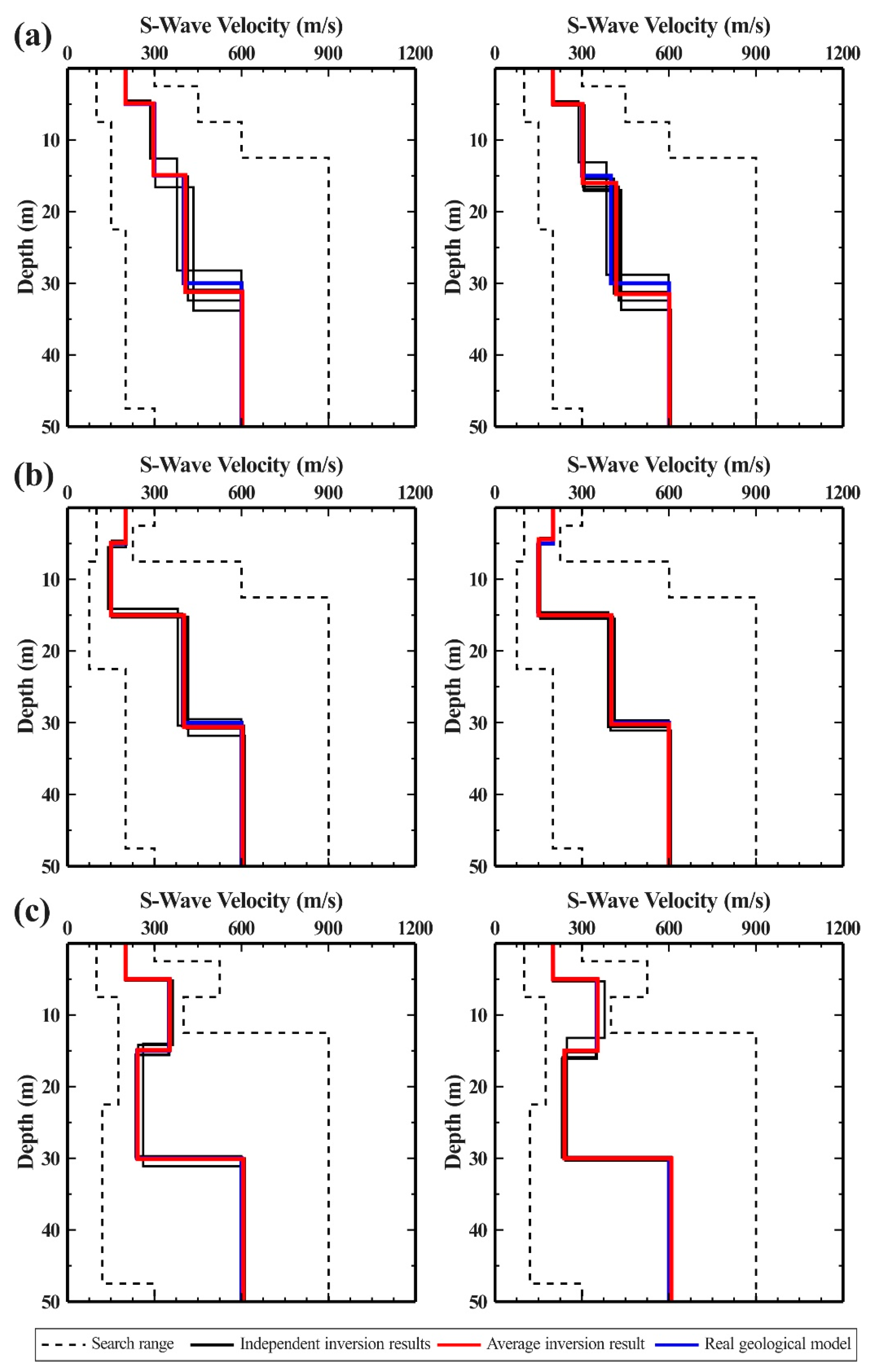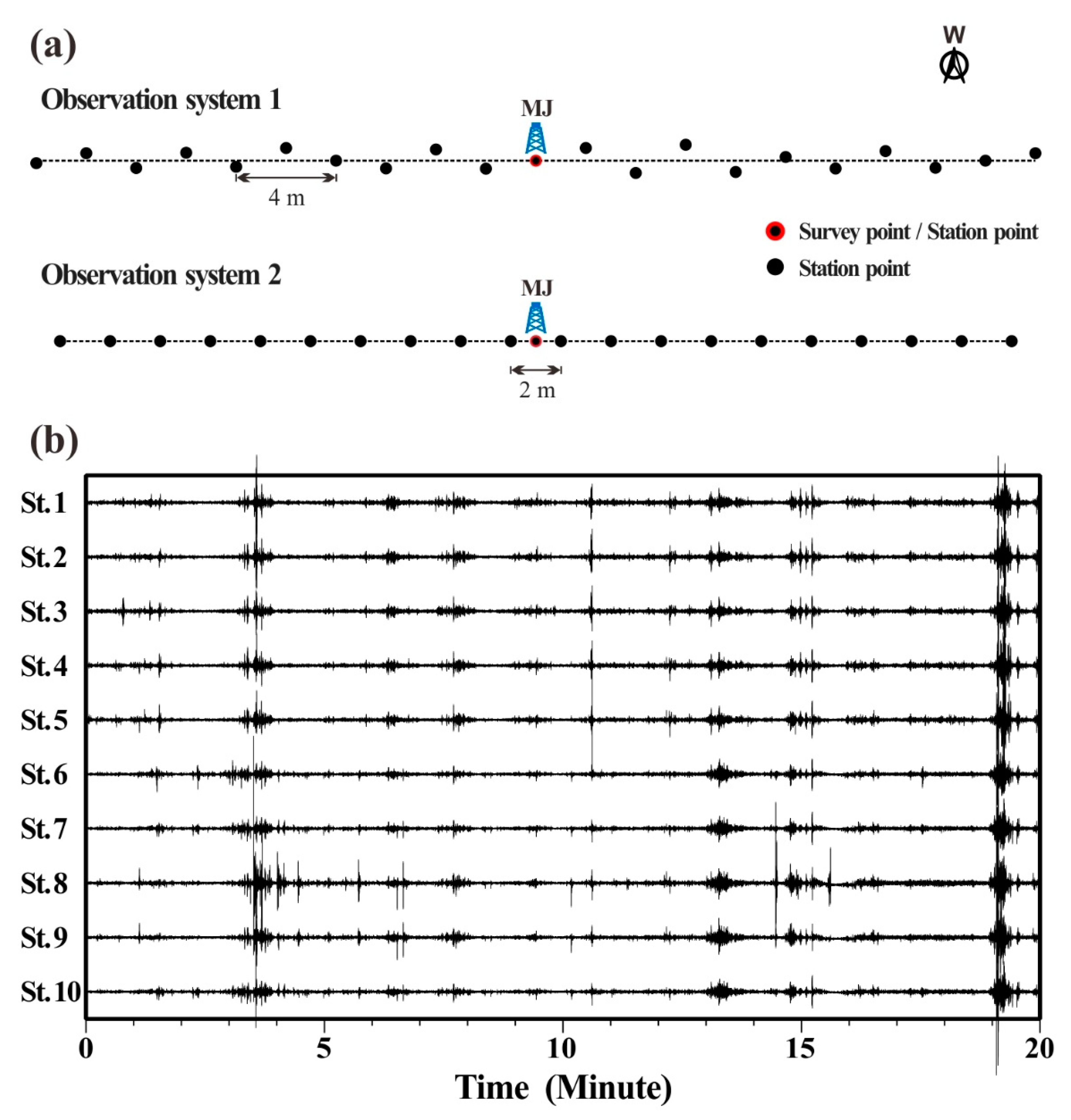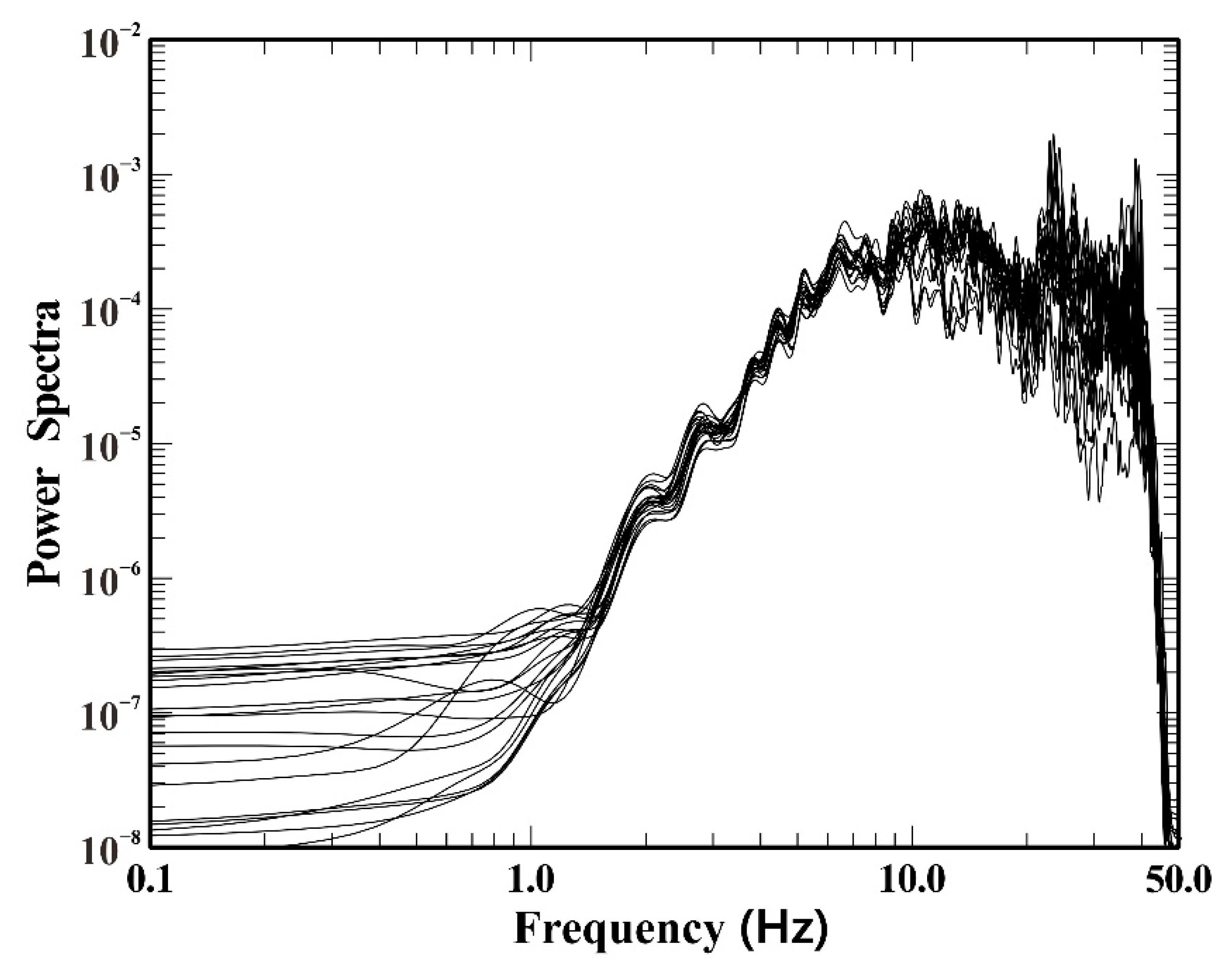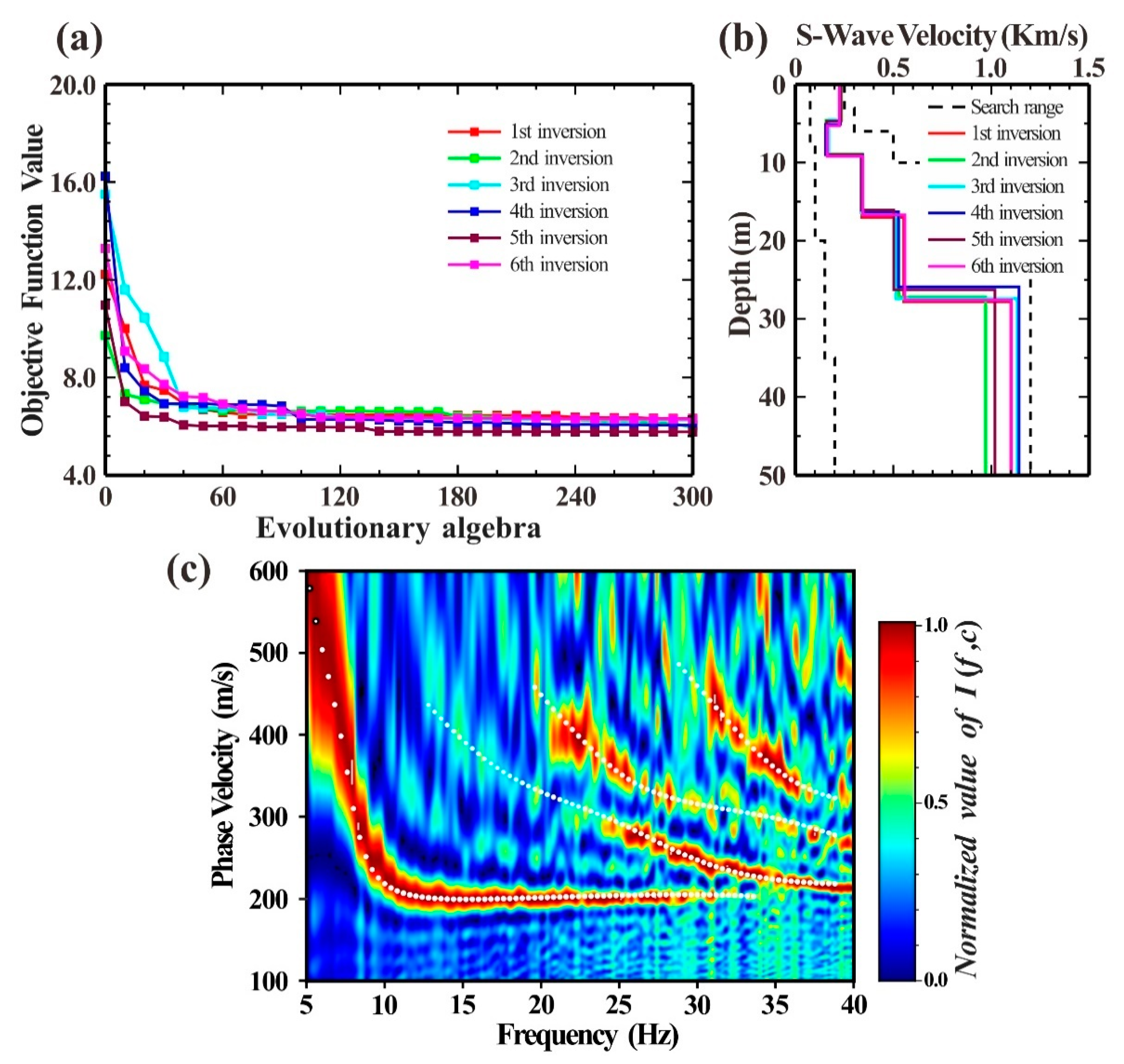Frequency-Bessel Transform Based Microtremor Survey Method and Its Engineering Application
Abstract
:1. Introduction
2. Methodology
2.1. Frequency-Bessel (F-J) Transform
2.2. Construction of New Inversion Objective Function
3. Numerical Tests
3.1. Selection of Geological Model
3.2. Theoretical Synthesis of Microtremor Signals
3.3. Microtremor Signal Processing
3.4. Inversion of Multi-Mode Dispersion Curve
4. An Engineering Application Verification
4.1. Site Overview
4.2. Data Acquisition
4.3. Measured Microtremor Signal Processing
5. Conclusions
Author Contributions
Funding
Institutional Review Board Statement
Informed Consent Statement
Conflicts of Interest
References
- Aki, K. Space and time spectra of stationary stochastic waves, with special reference to microtremors. Bull. Earthq. Res. Inst. 1957, 35, 415–456. [Google Scholar]
- Bonnefoy-Claudet, S.; Cotton, F.; Bard, P.Y. The nature of noise wavefield and its applications for site effects studies: A literature review. Earth-Sci. Rev. 2006, 79, 205–227. [Google Scholar] [CrossRef]
- Okada, H. Theory of efficient array observations of microtremors with special reference to the SPAC method. Explor. Geophys. 2006, 37, 73–85. [Google Scholar] [CrossRef] [Green Version]
- Wu, C.F.; Huang, H.C. Detection of a fracture zone using microtremor array measurement detection of a fracture zone. Geophysics 2019, 84, B33–B40. [Google Scholar] [CrossRef]
- Xu, P.F.; Ling, S.Q.; Li, C.J.; Du, J.G.; Zhang, D.M.; Xu, X.Q.; Dai, K.M.; Zhang, Z.H. Mapping deeply-buried geothermal faults using microtremor array analysis. Geophys. J. Int. 2012, 188, 115–122. [Google Scholar] [CrossRef]
- Xu, P.F.; Li, S.H.; Du, J.G.; Ling, S.Q.; Guo, H.L.; Tian, B.Q. Microtremor survey method: A new geophysical method for dividing strata and detecting the buried fault structures. Acta Petrol. Sin. 2013, 29, 1841–1845. [Google Scholar]
- Xu, P.F.; Shi, W.; Ling, S.Q.; Guo, H.L.; Li, Z.H. Mapping spherically weathered “Boulders” using 2D microtremor profiling method: A case study along subway line 7 in Shenzhen. Chin. J. Geophys. 2012, 55, 2120–2128. [Google Scholar]
- Khedr, F.; Marzouk, I.; Elrayess, M. Site effect estimation using Horizontal to Vertical (H/V) spectral ratio technique in Nile Delta, Egypt. NRIAG J. Astron. Geophys. 2019, 8, 84–96. [Google Scholar] [CrossRef] [Green Version]
- Xu, P.F.; Ling, S.Q.; Ran, W.Y.; Liu, Q.X.; Liu, J.G. Estimating cenozoic thickness in the Beijing plain area using array microtremor data. Seismol. Res. Lett. 2013, 84, 1039–1047. [Google Scholar] [CrossRef]
- Zhang, R.H.; Xu, P.F.; Ling, S.Q.; Du, Y.N.; You, Z.W.; Wang, Z.H.; Sun, C.Y. Detection of the soil-rock interface based on microtremor H/V spectral ratio method: A case study of the Jinan urban area. Chin. J. Geophys. 2020, 63, 339–350. [Google Scholar]
- Yan, Y.F.; Sun, C.Y.; Lin, T.F. Mapping water-rich goaf utilizing microtremor exploration method. In Proceedings of the SEG International Exposition and Annual Meeting, San Antonio, TX, USA, 15–20 September 2019. [Google Scholar]
- Du, Y.N.; Xu, P.F.; Ling, S.Q. Microtremor survey of soil-rock mixture landslides: An example of Baidian township, Hengyang City. Chin. J. Geophys. 2018, 61, 1596–1604. [Google Scholar]
- Xia, J.G.; Gao, W.; Cheng, Y.X.; Hu, R.L.; Xu, P.F.; Sui, H.Y. A new approach for precise detection of the geological structure of soil-rock mixture deposit and its application. Rock Soil Mech. 2018, 39, 3087–3094. [Google Scholar]
- Henstridge, J.D. A signal processing method for circular arrays. Geophysics 1979, 44, 179–184. [Google Scholar] [CrossRef]
- Ling, S.Q. Research on the Estimation of Phase Velocities of Surface Waves in Microtremors. Ph.D. Thesis, Hokkaido University, Hokkaido, Japan, 1994. [Google Scholar]
- Xu, P.F.; Ling, S.Q.; Long, G.; Qiao, G.Q.; Shen, Q.H.; Yao, J.; Zhang, H. ESPAC-based 2D mini-array microtremor method and its application in urban rail transit construction planning. Tunn. Undergr. Space Technol. 2021, 115, 104070. [Google Scholar] [CrossRef]
- Capon, J. High-resolution frequency-wavenumber spectrum analysis. Proc. IEEE 1969, 57, 1408–1418. [Google Scholar] [CrossRef] [Green Version]
- Lacoss, R.T.; Kelly, E.J.; Toksöz, M.N. Estimation of seismic noise structure using arrays. Geophysics 1969, 34, 21–38. [Google Scholar] [CrossRef]
- Wang, J.N.; Wu, G.X.; Chen, X.F. Frequency-Bessel transform method for effective imaging of higher-mode Rayleigh dispersion curves from ambient seismic noise data. J. Geophys. Res. Solid Earth 2019, 124, 3708–3723. [Google Scholar] [CrossRef] [Green Version]
- Luo, Y.H.; Xia, J.H.; Liu, J.P.; Liu, Q.S.; Xu, S.F. Joint inversion of high-frequency surface waves with fundamental and higher modes. J. Appl. Geophys. 2007, 62, 375–384. [Google Scholar] [CrossRef]
- Xia, J.H.; Miller, R.D.; Park, C.B.; Tian, G. Inversion of high frequency surface waves with fundamental and higher modes. J. Appl. Geophys. 2003, 52, 45–57. [Google Scholar] [CrossRef]
- Xia, J.H.; Xu, Y.X.; Chen, C.; Kaufmannet, R.D.; Luo, Y.H. Simple equations guide high-frequency surface-wave investigation techniques. Soil Dyn. Earthq. Eng. 2006, 26, 395–403. [Google Scholar] [CrossRef]
- Zhang, S.X.; Chan, L.S. Possible effects of misidentified mode number on Rayleigh wave inversion. J. Appl. Geophys. 2003, 53, 17–29. [Google Scholar] [CrossRef]
- Gao, L.L.; Xia, J.H.; Pan, Y.D. Misidentification caused by leaky surface wave in high-frequency surface wave method. Geophys. J. Int. 2014, 199, 1452–1462. [Google Scholar] [CrossRef] [Green Version]
- Wang, J.N. Vector Wavenumber Transformation Method to Extract Multimode Dispersion Curves from Ambient Seismic Noise. Ph.D. Thesis, University of Science and Technology of China, Hefei, China, 2017. [Google Scholar]
- Sato, H.; Fehler, M.C.; Maeda, T. Green’s function retrieval from the cross-correlation function of random waves. In Seismic Wave Propagation and Scattering in the Heterogeneous Earth, 2nd ed.; Springer: Berlin/Heidelberg, Germany, 2012; pp. 401–450. [Google Scholar]
- Chen, X.F. Seismogram synthesis in multi-layered half-space Part I. theoretical formulations. Earthq. Res. China 1999, 13, 53–78. [Google Scholar]
- Zhang, H.M.; Chen, X.F.; Chang, S.H. An Efficient Numerical Method for Computing Synthetic Seismograms for a Layered Half-space with Sources and Receivers at Close or Same Depths. Pure Appl. Geophys. 2003, 160, 467–486. [Google Scholar] [CrossRef]
- Chen, X.F. A systematic and efficient method of computing normal modes for multilayered half-space. Geophys. J. Int. 1993, 115, 391–409. [Google Scholar] [CrossRef] [Green Version]
- He, Y.F.; Chen, W.T.; Chen, X.F. Normal mode computation by the generalized reflection-transmission coefficient method in planar layered half pace. Chin. J. Geophys. 2006, 49, 1074–1081. [Google Scholar] [CrossRef]
- Lu, L.Y.; Zhang, B.X.; Wang, C.H. Experiment and inversion studies on Rayleigh wave considering higher modes. Chin. J. Geophys. 2006, 49, 1082–1091. [Google Scholar] [CrossRef]
- Cai, W.; Song, X.H.; Yuan, S.C.; Hu, Y. A new misfit function for multimode dispersion curve inversion of Rayleigh waves. Earth Scietce 2017, 42, 1608–1622. [Google Scholar]
- Herrmann, R.B. Computer programs in seismology: An evolving tool for instruction and research. Seismol. Res. Lett. 2013, 84, 1081–1088. [Google Scholar] [CrossRef]
- Zhou, X.H.; Lin, J.; Zhang, H.Z.; Jiao, J. Mapping extraction dispersion curves of multi-mode Rayleigh waves in microtremors. Chin. J. Geophys. 2014, 57, 2631–2643. [Google Scholar]
- Bonnefoy-Claudet, S.; Cornou, C.; Kristek, J.; Ohrnberger, M.; Cotton, F. Simulation of seismic ambient noise: I H/V and array techniques on canonical models. In Proceedings of the 13th World Conference on Earthquake Engineering, Vancouver, BC, Canada, 1–6 August 2004; p. 1120. [Google Scholar]
- Tokimatsu, K.; Tamura, S.; Kojima, H. Effects of multiple modes on Rayleigh wave dispersion characteristics. J. Geotech. Eng. 1992, 118, 1529–1543. [Google Scholar] [CrossRef]
- Wang, S.; Sun, X.L.; Liu, L.B.; Zong, J.Y. Sub-surface structures and site effects extracted from ambient noise in metropolitan Guangzhou, China. Eng. Geol. 2020, 268, 105526. [Google Scholar] [CrossRef]













| Layer Serial Number | Layer Thickness (m) | Model 1 | Model 2 | Model 3 | ||||||
|---|---|---|---|---|---|---|---|---|---|---|
| V1 | V2 | ρ | V1 | V2 | ρ | V1 | V2 | ρ | ||
| 1 | 5 | 1611 | 200 | 1.725 | 1611 | 200 | 1.725 | 1611 | 200 | 1.725 |
| 2 | 10 | 1695 | 300 | 1.784 | 1582 | 150 | 1.697 | 1743 | 350 | 1.809 |
| 3 | 15 | 1798 | 400 | 1.834 | 1798 | 400 | 1.834 | 1641 | 240 | 1.750 |
| 4 | ∞ | 1969 | 600 | 1.920 | 1969 | 600 | 1.920 | 1969 | 600 | 1.920 |
| Layer Serial Number | Search Interval of Layer Thickness (m) | Search Interval of S-Wave Velocity (m/s) | ||
|---|---|---|---|---|
| Model 1 | Model 2 | Model 3 | ||
| 1 | 2.5~7.5 | 100~300 | 100~300 | 100~300 |
| 2 | 5~15 | 150~450 | 75~225 | 175~525 |
| 3 | 5~25 | 200~600 | 200~600 | 120~400 |
| 4 | ∞ | 300~900 | 300~900 | 300~900 |
| Layer Serial Number | Model 1 | Model 2 | Model 3 | |||||||||
|---|---|---|---|---|---|---|---|---|---|---|---|---|
| Err1 (%) | Err2 (%) | Err3 (%) | Err4 (%) | Err1 (%) | Err2 (%) | Err3 (%) | Err4 (%) | Err1 (%) | Err2 (%) | Err3 (%) | Err4 (%) | |
| 1 | 2.67 | 0.17 | 0.33 | 0.08 | 3 | 0.08 | 6.33 | 0.25 | 0.43 | 0.26 | 0.33 | 0.24 |
| 2 | 0.17 | 1.17 | 9.8 | 0.78 | 1 | 0.22 | 3.33 | 0.44 | 0.67 | 0.81 | 0.75 | 1.24 |
| 3 | 8.33 | 1.58 | 3.22 | 4.42 | 3.67 | 0.46 | 1.44 | 0.25 | 1.44 | 0.83 | 0.56 | 1.14 |
| 4 | --- | 0.5 | --- | 0.31 | --- | 0.61 | --- | 0.06 | --- | 1.00 | --- | 1.36 |
| Inversion Serial Number | Calculation Time of Traditional Inversion Objective Function (s) | Calculation Time of Newly Proposed Inversion Objective Function (s) | ||||
|---|---|---|---|---|---|---|
| Model 1 | Model 2 | Model 3 | Model 1 | Model 2 | Model 3 | |
| 1 | 6562.88 | 8963.45 | 6489.65 | 69.17 | 83.94 | 66.05 |
| 2 | 6462.36 | 9032.13 | 6875.24 | 67.81 | 83.30 | 66.08 |
| 3 | 6655.34 | 9268.64 | 6259.36 | 60.73 | 83.55 | 65.47 |
| 4 | 6034.07 | 9149.32 | 6387.68 | 61.58 | 83.70 | 64.94 |
| 5 | 6243.52 | 8989.64 | 6512.35 | 60.41 | 86.88 | 64.25 |
| 6 | 6368.43 | 9432.61 | 6659.84 | 62.19 | 86.36 | 65.06 |
| Name | Model | Main Performance Indicators |
|---|---|---|
| Geophone | CDJ-S2C | Velocity type: |
| three-component | ||
| Natural frequency: 2 ± 10% Hz | ||
| Voltage output sensitivity: 2 ± 10% V/cm/s | ||
| Coil resistance: 6040 ± 5% KΩ | ||
| Damping coefficient: 0.7 ± 10% | ||
| Data Logger | LS-8800 | Number of data channels: 3 |
| A/D conversion: 24 bits | ||
| Sampling frequency: 100 Hz or 200 Hz | ||
| Dynamic range: 128 dB | ||
| Time correction: real-time GPS automatic correction | ||
| Applicable temperature: −20~+50 °C |
Publisher’s Note: MDPI stays neutral with regard to jurisdictional claims in published maps and institutional affiliations. |
© 2022 by the authors. Licensee MDPI, Basel, Switzerland. This article is an open access article distributed under the terms and conditions of the Creative Commons Attribution (CC BY) license (https://creativecommons.org/licenses/by/4.0/).
Share and Cite
You, Z.; Xu, P.; Qian, J.; Cao, L.; Du, Y.; Fu, Q. Frequency-Bessel Transform Based Microtremor Survey Method and Its Engineering Application. Int. J. Environ. Res. Public Health 2022, 19, 13484. https://doi.org/10.3390/ijerph192013484
You Z, Xu P, Qian J, Cao L, Du Y, Fu Q. Frequency-Bessel Transform Based Microtremor Survey Method and Its Engineering Application. International Journal of Environmental Research and Public Health. 2022; 19(20):13484. https://doi.org/10.3390/ijerph192013484
Chicago/Turabian StyleYou, Zhiwei, Peifen Xu, Jing Qian, Lianpeng Cao, Yanan Du, and Qiang Fu. 2022. "Frequency-Bessel Transform Based Microtremor Survey Method and Its Engineering Application" International Journal of Environmental Research and Public Health 19, no. 20: 13484. https://doi.org/10.3390/ijerph192013484





